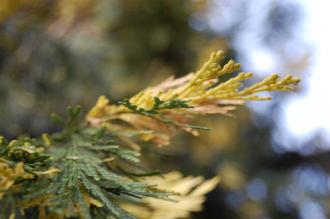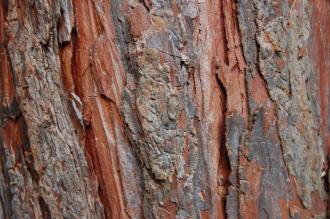
Calocedrus decurrens ‘Aureovariegata’ (27/01/2013, Kew Gardens, London)
Position: Full sun to partial shade
Flowering period: Late spring
Soil: Moist, well drained
Eventual Height: 25m
Eventual Spread: 5m
Hardiness: 7a – 9b
Family: Cupressaceae
Calocedrus decurrens ‘Aureovariegata’ is a slow growing, evergreen tree with a upright conical habit. Its mid green and yellow leaves are scale like, up to 15mm long and produced in flattened sprays. Its trunk may achieve a diameter of up to 2m. Its bark is orange/ brown, smooth when young, becoming fissured and peels off in strips as it matures. Its flowers are pollen cones and are up to 8mm long. Its fruit are in the form of cones, are initially pale green, maturing to yellow/ brown and are up to 35mm long.

Calocedrus decurrens ‘Aureovariegata’ Leaf (27/01/2013, Kew Gardens, London)
The species Calocedrus decurrens, commonly known as the Incense Cedar or Californian Incense Cedar, is native to western North America.
The etymological root of the binomial name Calocedrus is derived from the Greek Kalos meaning ‘beautiful’ and Cedrus another genus of coniferous tree. Decurrens is derived from the Latin decurrere meaning ‘flowing down’, in reference to the leaf margins running into the stem. Aureovariegata is derived from the Latin aureus meaning ‘golden’ and variegata meaning ‘variegated’.
The landscape architect may find Calocedrus decurrens ‘Aureovariegata’ useful as a conical ornamental tree with a variegated leaf pattern. Once established this tree is drought tolerant.
Ecologically, Calocedrus decurrens ‘Aureovariegata’ may be a host to a number of insects who inhabit the crevices of the mature bark.
The Royal Horticultural Society has given the species Calocedrus decurrens their prestigious Award of Garden Merit in 1993.

Calocedrus decurrens ‘Aureovariegata’ Bark (27/01/2013, Kew Gardens, London)
Calocedrus decurrens ‘Aureovariegata’ prefers moist, deep, humus rich, well-drained soils. It tolerates most pH of soil although it prefers acidic.
Calocedrus decurrens ‘Aureovariegata’ requires little maintenance.

